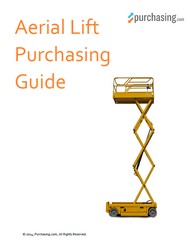Introduction to the Aerial Lift Buying Process
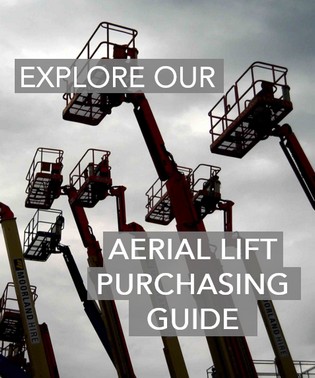 Table of Contents
Table of Contents
- Types
- Specifications
- Accessories & Attachments
- Questions to Ask a Dealer
Introduction
Aerial lifts are a versatile and valuable piece of material handling equipment. Different from a standard forklift, these lifts can access those hard-to-reach places. Different lifts with varying boom types can reach high shelves or working areas, go up and over obstacles and enable material and cargo movement on many different surfaces. Some lifts come with stabilizing legs for added security and safety for your employees.
Aerial lifts are found in diverse industries. Manufacturing environments use them to store resources and materials, as well as reach behind and around large, stagnant pieces of equipment. Warehousing industries use the lifts to store products on high shelves. Construction and utility companies find aerial lifts to be among the most useful and critical pieces of equipment in their fleet. Emergency rescue crews also use bucket lifts and stabilizers in their work.
When looking at purchasing an aerial lift, there are four critical factors that you must know the answer to before starting your search:
- What is your working height?
- What is your weight capacity?
- What is your horizontal reach?
- Are you working indoors or outdoors?
The answers to those questions will help you determine the type of aerial lift you need.
Cost
The price of an aerial lift will vary on the type of the lift, how far it needs to reach, the weight it will elevate, and the type of engine used to power its activity. They range from $5,000 to $80,000, depending on the type of lift you are looking to acquire. Properly maintained, an aerial lift will operate for several years with no issues.
Purchasing a used aerial lift can be a viable option, as used aerial lifts offer all of the same options and benefits as new equipment. Just be sure to ask for maintenance records and check hours of operation. Compare number of hours against the age of the machine to see how much it has been used in its lifetime.
Once you have determined the type of aerial lift you need, condition (new or used), and how much you are willing to spend, you're ready to begin the purchasing process. If you need a lender, choose a financial institution with experience in heavy equipment lending. Their industry knowledge may provide some insights as you make specific decisions in your lift choice.
A good dealer will walk you through the process of selecting options that fit within your budget and help you set up a payment plan if needed. They will need information from you about your company, but once you have an approved amount to spend, you can begin the hunt and narrow down the search for the perfect aerial lift to meet your organization’s needs.
This purchasing guide will give you more information about the types of aerial lifts, different specifications to consider, what attachments or accessories are available, and questions to ask dealers during your search.
Types
Aerial lifts describes a broad selection of lifts that can reach high, extend out, and move side to side. This is what makes them significantly different than other material handling equipment. In size and shape, they can be as small as a pallet jack, able to be pushed or towed to a location. Others are large self-propelled models that need an escort to move down the highway. Each type has features and benefits that work better in some industries more than in others.
Spider Lift
A spider lift is a type of aerial lift that uses stabilizing booms, or “legs” that are extended and placed in such a way as to stabilize the platform. Compacted, these lifts are narrow and require little space in which to maneuver but when extended, have a large working area.
Spider lifts work well for landscaping, window washing and interior projects where protecting the flooring is critical. They come in three height ranges and can be operated by a single person. Spider lifts save time and increase safety by nearly eliminating the need for scaffolding. Combined with the right accessories, this allows personnel to complete their tasks faster and more efficiently. There are also large, industrial versions with track instead of wheels for rough terrain and higher grade areas for construction and commercial use.
The type of aerial lift has a significant impact on cost. The price range for a used spider lift varies from $15,000 to $65,000 while new lifts range from $25,000 to $115,000.
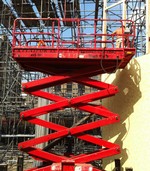
Scissor Lift
Scissor Lift
Scissor lifts are hydraulic powered platforms that go up and down with no horizontal reach. They can reach up to 50 feet, although 20 to 30 feet is most common. A key benefit to a scissor lift over other aerial lift types is that it elevates a larger workspace and can lift much heavier weights than lifts equipped with buckets.
They are used in the construction industry with additional uses in building maintenance, agriculture, and some interior warehouses. They are available in either electric or engine powered hydraulics, ranging from $12,000 to $70,000, new and used.
Boom Lift
A boom lift is the most versatile of all aerial lifts. Boom lifts can reach up, down, frontwards, backwards, sideways, and up and over. Depending on which type you pick from the selection below, and if it is used or new, a boom lift can cost $22,000 to $210,000.
- Telescopic. The selling point of a telescopic boom lift is its horizontal reach. With a horizontal reach from just a few feet to 80 feet, they can stretch to those areas with constricted or limited access, especially in construction or industrial areas.
- Articulating. The articulating boom lift can extend the boom and once extended, can also move from side to side. With a bucket attachment, personnel can stay elevated and move from project to project without moving the base. This saves time in lowering and raising the boom, as well setting up several different times while moving down a line.
- Trailer Mounted. Trailer mounted booms are the most mobile of the boom lifts as they can be towed behind a pickup truck, SUV or work van. The controls are simple and intuitive while offering multiple uses. The boom (also known as a “Z boom”) is jointed and can reach up and over at the same time when extended. The compact design and light weight make it a perfect choice for jobs where your personnel need to attain height but are concerned about damaging the surface on which the boom rests, like a lawn or floor.
Personnel Lift
A personnel lift is a compact push-able or towable lift used indoors for maintenance purposes for institutions like churches, hospitals, and schools or internal construction work. Not much larger in width or length than the average pallet jack, it is equipped with a single person platform with guard rails for safety. The control box is in the platform with the operator who can raise and lower themselves as needed once it is set up.
Personnel lifts can cost between $10,000 and $35,000, depending on the manufacturer and hydraulic set up.
Vehicle Mounted Cherry Picker
Otherwise known as a self-propelled cherry picker, the vehicle mounted cherry picker can attain platform heights exceeding 80 feet. Cherry pickers were developed for agriculture so that personnel could pick the high hanging fruit, hence the name. They have been adapted for a wide range of uses, both internal and external, beyond growers to construction, industrial and commercial uses. They can be used as a static base and many models come up with legs to increase stability for higher heights if necessary.
The cherry picker price range is from $22,500 to $94,000.
Back to top
Specifications
It's essential to identify what size, power source and drive system you need. You may find that it changes your initial understanding of what type of lift will best meet all of your requirements.
Size
The size of the lift matters when you have tight or restricted access to work areas. Aisles in many warehouses and manufacturing areas are 4 to 8 feet wide. The legs of a spider lift can extend from 6 to 20 feet. So being narrow enough to access a working area does not necessarily mean the lift will be fully operational once there. Construction sites can have similar narrow access points and hard to reach elevated work areas. The challenge in those instances is finding a lift capable of the job than can perform optimally in space allowed.
Smaller lifts will cost less money but may have an operational cost as well. They have a lower base weight, which limits weight capacity and can affect center of balance when looking at distance of horizontal reach. The lower the center of balance is, the further distance the platform can extend away from the lift. The surface on which you normally work may not bear the weight of a larger lift without damage, such as gymnasium floors.
Power
The first determining factor in choosing a power source is worksite: indoors or outdoors.
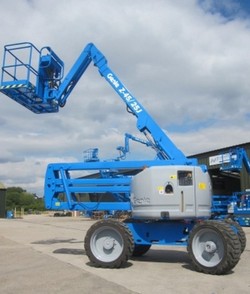
Large Hybrid Engine Lift
- Electric. If you are working indoors, an electric power source is a reasonable choice. There are no fumes or emissions to worry about, charging stations should be readily accessible and batteries are easy to maintain.
- LP or propane. An outdoor working situation leaves only two choices for power. LP or propane power is great for portable situations. Canisters or tanks can easily be transported or stored, reducing time spent acquiring supply or refueling. They can provide great power for shorter periods of time than diesel when electric power is not an option.
- Diesel. Diesel provides the most power out of the available power source options for aerial lifts. It is used primarily in the large rough terrain models, giving the lift the ability to traverse over uneven land and power lifts that need increased weight capacity or horizontal reach coupled with amplified working height.
- Hybrid or Bi-energy. Many manufacturers are offering dual power source options. This increases the flexibility and functionality of the machine. On electric power it can be used indoors or in low power outdoor situations while being able to fire up an engine with propane or diesel can increase power, travel distance and reduce down time recharging or refueling.
The power source for your lift can affect cost. Electric options tend to be cheaper in purchase cost than engine powered lifts and spread out charging costs over the years you own the lift. Propane and LP options are more expensive but that is also due to the increased capabilities.
Maintenance costs for both LP, propane and diesel options are higher than electric because the engines have additional maintenance needs beyond the hydraulics, tires and drive system. Over the life of electric and LP models, electric models run about 10% cheaper in upfront costs and long-term maintenance. Diesel power is driven by the need, not by the cost.
Drive Systems
The drive system you need is once again determined by where you are going to operate the lift. A tracked drive system is not good for a gymnasium floor while two-wheel drive may not get you far enough into swampy ground to get work started.
- Tracks. Large aerial lifts with track drive systems are perfect for outdoor jobs in hard-to-get-to places. The tracks can go over any grade and type of material, minimizing obstacles and blazing a trail for follow-on equipment. They also tend to reach the highest heights, lift the most weight and extend out the farthest horizontally.
- Towable. Towable models are great for transportability and to reach narrow or other inaccessible areas. The legs fold up neat and compact, reducing the space necessary to use or store the lift. While not as powerful as self-propelled two-wheel drive, four-wheel drive, or tracked models, these have an impressive weight, height, and reach capacity for their size and make a good all-around option for general work in all industries.
- 2 wheel drive. Two-wheel drive, self-propelled lifts can work on most uneven, stable surfaces. They are not well equipped to deal with significant slope or grade and are larger than their towable counterparts with about the same capabilities. However, they have additional storage and ridership qualities that may fit your situation better than other options.
- 4 wheel drive. Four-wheel drive can get you in, and out, of situations that two-wheel cannot and that you dare not got go with larger and heavier track aerial lifts. With increased lift, height and reach ability, this is a heavy duty option with size and transportability upsides that other drive systems may not offer.
The drive system itself does not reduce or increase cost of a lift as the type of drive system is normally dependent on the purpose of the lift.
Back to top
Accessories & Attachments
Aerial lift accessories and attachments can considerably increase the functionality of an aerial lift. It turns one piece of equipment into a valued asset on many different types of jobs and tasks. The addition of a deck extension, for instance, can increase reach while a welding package integrated with the lift can reduce setup time, increase safety and make a person’s job much easier.
Below, are accessories to consider:
Cutting package. With the installation of a cutting package on an aerial lift, the saw is held by an onboard hydraulic manipulator. Workers can cut with ease and accuracy. The hoses and water lines are located along the power track to supply power and clean up capability.
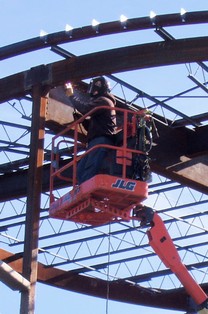
Lift With Welding Package
Welding package. A welding package for an aerial lift is mounted and installed directly on the platform. Workers will not have to assemble and take up separate tools to perform the work. Many features and parts of the welding kit are connected to the main unit so that if they are dropped, they do not fall to ground, possibly injuring staff. The welder itself is wired into the lift’s power supply.
Panel carrier. This provides a trough mounted on the outside of the platform that workers can slide panels of drywall or other material. A bracket secures the panels in place during transport and extension of the lift so that they don't tip over or fall off.
Pipe rack. A pipe rack offers “off the platform” or deck storage for pipes and conduit, freeing up work space on the platform. It adds to safety by removing tripping hazards and keeps workers from bending over frequently to pick them up. It also offers additional storage during installation and transport.
Glazier package. The glazier package accessory enables your crew to get their glass and work materials to the job site safely and efficiently, as well as allow for effective work while in the air. It is the added safety benefit of reducing worker fatigue.
Deck extension. This accessory increases the productivity of any lift by adding workspace and an “up and over” reach capability. At one time, manufacturers only offered them on spider lifts but they grew to be so popular that most manufacturers make them standard options. There are even dual deck extensions available for some models.
Safety features are an important aspect to an aerial lift. Besides fall protection, there are other safety items that are built in or can be purchased to enhance the safety and security of your personnel as they go about their day.
- Static straps are used to ground the lift to protect workers from static shock.
- The manual descent valve is how the lift would lower in the event of a power loss. It lets hydraulic fluid back into the pump reservoir and the platform lowers slowly and safely under its own weight.
- Level warnings monitor the balance of the lift platform. An alarm, lights, or emergency cutoff activates when the platform is out of balance for reasons like rough terrain or high winds.
- Pothole protection is a system of safety arms, similar to legs or outriggers, which can be used while the lift is moving. In the event the lift becomes unbalanced, it catches the lift and platform before the tip reaches dangerous levels.
Whatever add-ons, accessories, or attachments you decide you need, check with your dealer or manufacturer to be sure that the model you’re looking at can support the desired add-ons. If the accessory does not work well with your lift, it can cause safety problems and be a waste of money.
Back to top
Questions to Ask a Dealer
As you search for an aerial lift dealer who meets your needs, be sure to discuss these items. While weight capacity and working height are critical, it is also important to find out how your personnel will learn to use the equipment, what keeps them safe, what training is available, and what long-term maintenance, repair and warranty packages are available.
Training resources. Most of the major manufacturers offer training online. Dealers may also offer one-on-one training or what is known as “train the trainer” instruction where they train one person from your company and that person comes back to train everyone else. Evaluate the online portion to see if it meets not just OSHA requirements (most do) but your safety program requirements for first-time training. Online is an excellent refresher option.
Safety features. Ask the dealer what safety features come with the lift, what can be purchased from the manufacturer as an option before delivery, and what accessories or attachments are approved after purchase or after market. Purchasing an accessory and having it installed before delivery may be the best value option, if not the cheapest. Explore the possibilities with your dealer. Safety is the employer’s responsibility and you want to do everything you can, in the most affordable and reasonable way, to protect your workers, their time and your job site.
Courses. Find out if a dealer or manufacturer offers classroom or course training. In-person training has been proven to be more effective and longer lasting than online training. There are also courses offered by the manufacturer for repair and maintenance. Getting certified by the manufacturer to do your own repairs can save you money in the long run, depending on your fleet size.
Get Quotes
- We contact sellers
- They compete for your business
Financing options. Just like buying a car, there are many financing options available when purchasing an aerial lift, new or used. Your dealer can work with your lender and help you determine the option that makes the most sense for you.
Maintenance and repairs. Ask where maintenance and repairs can be done; can they can be done onsite, in your primary location garage, or does the lift have to come back to dealer’s garage? There can be hidden costs in that answer that you will need to consider, especially if the lift has to travel or be transported a considerable distance back to the dealer.
Warranties. As an incentive to purchase, dealers may offer warranties on new and used aerial lifts. Ask what is available in the model you are looking at or what they can do to offer one to you. A warranty can protect you from unknown and unplanned events in your equipment purchase.
Deciding you need an aerial lift is one thing; deciding on the right type of lift with all the options, features, and ancillary expectations is another. By considering each aspect of an aerial lift, you are certain to find an affordable aerial lift that makes your business better.
Back to top
